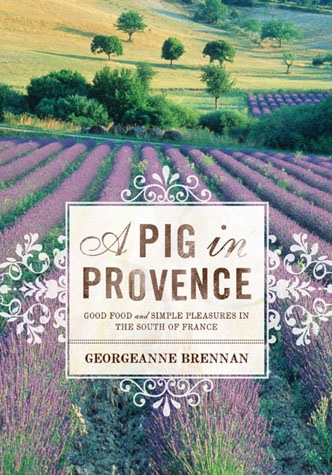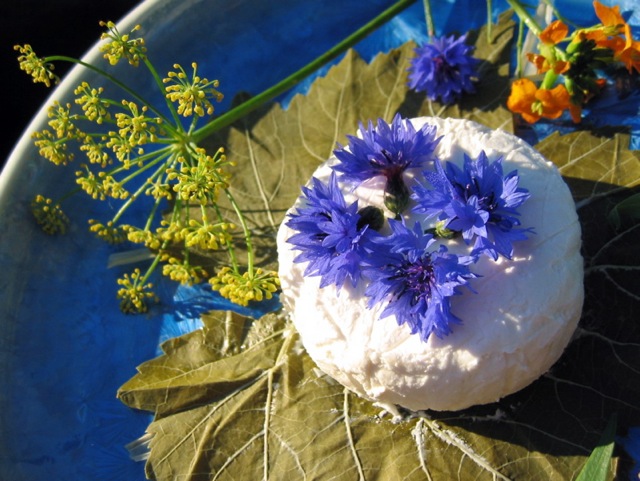
reference-image, l
(article, Georgeanne Brennan)
[%adInjectionSettings noInject=true] [%pageBreakSettings nobreak=true] h3. From Chapter 1: "A Personal History of Goat Cheese" p(blue). Editor's note: In this excerpt, a young Brennan, newly arrived in 1970s Provence, is taken to visit a local cheesemaker. "I've come with the American, for you to tell her about cheese." Mme. Lacoste turned to me and said, "My grandmother made cheese too, of course, but now, no matter what question you ask her, she only talks about certain things, like the Germans, her dead husband, her wedding trip to Nice." "Bonjour, Madame Rillier," I said to my companion's mother. She gave me a no-nonsense handshake, and I understood where Mme. Lacoste had acquired her manner. [[block(sidebar). h1. About the book and author In 1970, Georgeanne Brennan moved to Provence with her husband and small daughter to raise goats, make cheese, and live a rural, traditional life. A Pig in Provence is Brennan's memoir of her time living in France. Excerpt reprinted with permission of Chronicle Books (2007). ]] "So. You want to make cheese our way. No cheese in America?" She put her hands on her hips and looked me up and down. "Yes, there's cheese, but not goat cheese. Not like the French homemade goat cheese." The term artisanal was not yet in my vocabulary. That would come 20 years later, with the beginning of the boom of artisanal foods in the United States. "Well, I'm glad someone is going to make it again. No one does anymore." No wonder I couldn't find any cheese, I thought. No one is making it. "I used to have seven or eight goats, milked them, and then made cheese," Mme. Rillier said. "I sold the extra cheeses. A few others around did the same. The others are dead now, and it got to be too much for me to do by myself. But I'll tell you how to do it. Come inside." Mme. Rillier pushed aside the bowls of soggy bread and food scraps set outside for chickens, a dog, and cats, all of whom were hovering nearby, and we followed her through a swinging screen door into the kitchen. The dog, a brown-and-white spaniel, was on a chain, and the circumference of the ground within his reach was worn bare with his pacing. "We've got to keep him on a chain, otherwise he runs off. Loose dogs get shot. My husband goes hunting with him." This was my first invitation into a family home kitchen since our arrival in Provence, and it wasn't at all what I expected. No authentic-looking copper pans gleaming over a well-used fireplace, no exposed wood ceiling beams, no soapstone or red tile sink, no terracotta pots filled with olives, no bright Provençal printed fabric. In short, this was not like the kitchen in the farmhouse we had rented one summer outside Aix-en-Provence. Over the next few years, as I came to know various farmhouse and modest village kitchens, I would find most of them very much like this one. Many had been modernized during the 1950s or 1960s, with some indoor plumbing and electricity installed, and a small, tubular white enamel water heater hanging over a utilitarian white sink set in faux granite or tiled cement. The walls of these kitchens were painted with multiple layers of pale green or cream-colored enamel, and the floors were red tiles if old, or tiles of inexpensive granite composite if new. An oil- or wood-burning stove both for cooking and for heat was set where a fireplace had once reigned, with the stove's pipe cut into the chimney flue. Sometimes the mantel was still there, with the pipe stretching beneath it. Somewhere, there would be a propane-fueled, two-burner stovetop or perhaps a modest new stove as well as the oil- or wood-burning one. Often, an overstuffed chair was in a corner and a small canapé, or couch, against a wall. It was early winter, and Mme. Rillier's kitchen was warm. Something that smelled of onions and garlic was cooking in a hissing pressure cooker on the back of the stove. A stew maybe, or dried beans, I thought. Greens freshly cut from the garden lay on the sink, along with the bucket of onions she had just brought in. A collection of succulents sat in small pots on the windowsill. On the wall, above an overstuffed brown chair covered with a crocheted afghan in shades of orange, blue, and brown, hung a shotgun. [%image promo-image float=right width=450 credit="Photo © Culinate" caption="The soft satisfaction of freshly made goat cheese."] "Here," Mme. Rillier said, reaching into a cupboard. "This is a cheese mold." She held a cuplike ceramic object, glazed ocher on the inside, the terracotta of the outside unglazed. It was perforated with a regular pattern of small round holes. She reached deeper into the cupboard and brought out several more molds in various sizes. "These are what I used. I think they might come in plastic now. Used to be someone in the village who made all the clay things we needed — daubières, tians, casseroles, bowls, and these cheese molds. He died during the war." The war again. It was still close to these people's lives, I realized. She would have been about 25 when the war ended, and her daughter was born during the war. I wondered again about the Germans. What was it like to live in this isolated place, Germans billeted in your house, your men gone to war or with la Résistance? "You make your cheese right after milking, while the milk is warm. Don't let it cool off. Pour the milk into a big bowl or bucket and add the rennet." This was the key moment for me. I quickly abandoned my imaginings about the war. "How much rennet?" "Just a tiny drop for, say, five liters. Not much. If you add too much, the cheese will be like rubber, full of holes and bitter." "And then what?" I asked, afraid that she had finished. "Then you cover the milk up and by morning it will be curdled. Or, if morning milk, curdled by dinner. Scoop the curd into the molds and set them out to drain. That's what the holes are for. The next day, salt the cheeses, turn them over, and let them drain another day. That's it." "That's it? What about aging? Isn't the cheese awfully soft?" "Of course it's soft. It's a fresh cheese. Every day you keep it, it gets older. Cheese is a living thing, you know, like wine. It changes, just like us, as it gets older. If you want an aged cheese, you keep it longer." This didn't exactly correspond to the USDA guidance about aging cheeses. "But if your cheeses are good, you won't have any to age. People will buy them right away. It's hard to get fresh cheese anymore. And we all remember it, right, Marie-Pierre?" She turned to her daughter, who agreed. "Well, that's it." Mme. Rillier put the cheese molds back into her cupboard. *Elsewhere on Culinate: A cheese primer.

reference-image, l

feature-image, l

promo-image, l

featurette-image, l